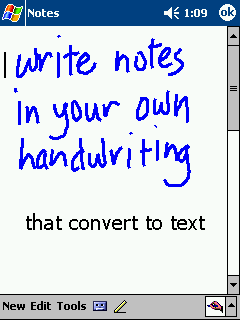|
||||||
|
Enjoy the music : |
||||||
 |
|
Handwriting Recognition Handwriting recognition Where space is limited, as with a PDA keyboard, typing can be slow and frustrating. Writing data into the PDA would obviously be a much more sensible idea, but the complexity involved in making handwriting recognition work is immense. The problem is that vector; line-drawn shapes do not make words. So what is the difference between a drawing of a house and the word shape for "wombat", for example? The human eye, of course, recognizes one as being a drawing and the other a word. There are two approaches a computer can take to resolving the matter. The easy approach is the one taken by the Graffiti recognition system. It understands each letter shape as a unique pattern for that letter, and converts each shape to its corresponding letter. There's no attempt at understanding words or context. To make it even easier, Graffiti uses some special character shapes which the user of the system has to learn.The approach taken by Newton was much more ambitious. It attempted to read the user'swriting and convert it into words. It sought to "learn" the way the user wrote, based on some standard test scripts and some interactive tutorials. This approach becomes increasing effective as the system recognizes more and more of the user's handwriting style. With Newton, it was possible to set up multiple user writing personalities, and thus it was important to always ensure that Newton always used the correct personality for a given user to avoid its knowledge base becoming "polluted". The apple was key to Newton, but sadly the Newton was a costly mistake for Apple. It will be remembered for the over-hype and for its bold, but ultimately unsuccessful attempt to solve the problem of handwriting recognition. The success of the Graffiti approach, on the other hand, was emulated by other developers. Communication Intelligence Corporation's (CIC) "Jot" and ParaGraph's CalliGrapher are two such systems often used by Windows CE and EPOC-based PDA's.
|
|

